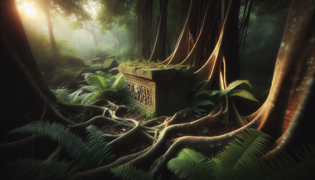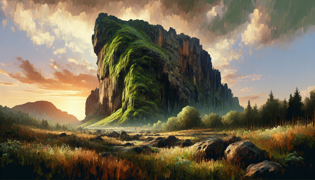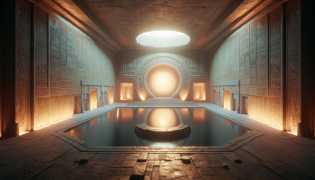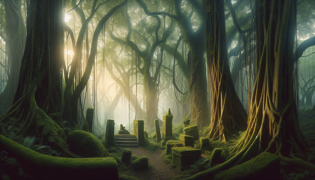Introduction
In the heart of Puerto Rico’s oldest rainforests, where sunlight filters through a dense ceiling of ceiba and flamboyant trees, there exists a tale older than any colonial chronicle. They say the Taíno ancestors built a sprawling city of stone and wood, its plazas ringed by temples carved with symbols of the sun and the stars. This city, Boriquén, thrived in harmony with the land, guided by wise caciques and nurtured by rituals that honored the spirits living in every river, every leaf, and every gust of wind. But as centuries passed, an age of greed dawned when outsiders arrived with swords and horses, seeking gold and glory. The brave guardians of Boriquén invoked ancient rites, summoning spirits of the forest to protect their home. In a single night of roaring thunder, the city vanished beneath vines and roots, swallowed by the jungle itself, leaving only whispered legends in its wake.
Generations of storytellers have passed down fragments of the legend. Some claim that glimpses of moss-covered plazas appear under moonlight when the mist is thick and the forest grows silent. Others tell of ghostly drums echoing in hidden caves and luminous pathways that vanish at dawn. Every explorer who sets foot on the overgrown trails feels the hum of unseen watchers, the weight of unseen eyes. None have returned unchanged. And while many seek Boriquén for fame or fortune, only those whose hearts are pure—and who respect the living spirit of the island—ever glimpse its hidden gateways. Whether it remains forever out of reach or lies waiting for the right soul to awaken its ancient magic, the legend endures, inviting us to listen to the whispers that flow between leaf and stone, memory and dream.
Whispers in the Canopy
Paragraph 1: High above the forest floor, the canopy of giants weaves a living tapestry of green. Sunlight dances across enormous leaves, illuminating veins and patterns as if the trees themselves speak in runes. Beneath this vault, the air is thick with the scent of damp earth, orchids, and the ghostly perfume of night-blooming flowers that close as the sun rises. Every branch seems to sway with a silent song, a murmured greeting from unseen spirits who have watched over these woodlands since time beyond recollection. Ancient ceiba trees stand sentinel, their roots like coiling serpents gripping the earth, suggesting that in their bark and boughs, the memory of Boriquén remains etched.
Paragraph 2: Explorers who venture into these depths report strange phenomena. At twilight, they speak of glowing motes drifting in the still air, which vanish if approached too closely. Some claim to hear faint drumming, as though a hidden ceremony unfolds just out of sight. It is said that those who press on without reverence hear the forest's warning: a chorus of whispers urging them to turn back. And yet, for dreamers seeking truth, the silence that follows is even more unnerving—a hush that falls over the leaves as though every creature in the undergrowth has paused to listen. It is here, in this shifting half-light, that the first fragments of ancient stone emerge amid thick vines, moss-coated and half-buried, hinting at walls and steps long swallowed by time.

Paragraph 3: The forest floor is a palimpsest of past and present. Among tangled roots and fern fronds, curious shapes appear—rounded stones carved with spiral motifs, fragments of pottery etched with jaguar claws, and broken idols sculpted in the likeness of the Guardian of Waters. Each relic carries an echo of Boriquén’s people, who regarded every living thing as kin. In their worldview, the boundary between human and spirit was permeable, and they honored both with equal devotion. To come upon these shards is to brush against that vanished world, to sense the pulse of a city alive with ceremony, laughter, and ritual. Yet as the sun climbs higher, the jungle reclaims its secrets: vines tighten around masonry, and the footprints of intruders are soon swallowed by leaf litter and moss. The ruins remain, but only for those who know how to look.
Guardians of the Ruins
Paragraph 1: Deep within the shadowed glades, where the forest’s heartbeat thumps in primal sync, stand the silent sentinels—massive statues sculpted from volcanic rock, half-engulfed by creeping vines. Legends hold that these colossi are the transformed forms of past caciques, their spirits bound by oath to protect Boriquén’s last sanctuary. Their faces, though eroded by centuries of rain and wind, still convey a brooding vigilance. Locals speak in hushed tones of feeling watched when passing these stone guardians, as though ancient eyes track every step. With each drop of rain that slides down their stony cheeks, the forest’s magic seems renewed, warding off those who come with greed in their hearts.
Paragraph 2: In the heart of the ruins lies a circular courtyard, paved with interlocked stones carved in concentric patterns. At its center stands a great monolith shaped like a hemisphere, its surface cleft with channels designed to catch and direct rainwater into a hidden cistern. The Taíno believed this sacred basin held the waters of the underworld and that only through pure intentions could one drink from it. They performed rites beneath flickering torches, drumming rhythms that echoed in the surrounding halls. Some modern explorers have uncovered shards of pottery and jade beads around the altar, suggesting offerings meant to placate the spirits and ensure safe passage. Yet despite these discoveries, attempts to remove artifacts invariably end in mishap—tools vanish, tents are torn by unseen gusts, and instruments crack without cause.

Paragraph 3: A handful of indigenous elders tell of a final guardianship ritual that remains unbroken. Under a moon hung like a silver pendant, a select few still gather at the forest’s edge. Clad in skins and feathers, they carry torches and drums, chanting in the old tongue. Their voices rise and fall with the night wind, weaving a protective circle through ancient incantations. Should any stranger slip between the lines, the flames flicker and die, and an otherworldly hush descends. In that silence, the forest proclaims its will: Boriquén belongs to those who honor the land, the spirits, and the memory of ancestors. When dawn breaks, the clearing appears abandoned, the ground smooth again, bearing no trace of the vigil. Yet when the moon returns to that same phase, the ritual resumes, ensuring the city’s fate remains sealed.
Echoes of Boriquén
Paragraph 1: Even if one eludes the guardians and uncovers a hidden doorway—or a subterranean stairway carved straight into living rock—the deeper one travels, the more palpable the presence of the old city becomes. Tunnels radiate outward from central chambers, their walls etched with pictographs depicting sun symbols, sea turtles, and coquí frogs. The freshly cut stone still holds the faint smell of sap and resin, preserved in the cool earth. Within these vaults, the echoes of footsteps bounce in eerie eternity, and every breath reverberates through corridors slick with moisture.
Paragraph 2: Above ground, the forest moves in perfect silence, as though all creatures pause in reverence for the city’s hidden heart. The air hums with energy: fireflies drift in patterns that mimic ancient constellations, and fleeting forms seem to flicker at the edge of vision. Travelers report their dreams haunted by the sounds of drums and chants—a lullaby of stone and spirit that lingers even on the brightest day. Some come seeking wisdom, hoping to decipher the Taíno’s sacred glyphs and learn the secrets of their herbal remedies. Others yearn simply to prove the city’s existence. Yet few leave with any proof: maps are smudged by tropical rains; photographs capture only shadows; journals become indecipherable upon exit.

Paragraph 3: In rare accounts, a chosen few describe a final chamber deep below the earth, where a ruined temple rests on a dais encircled by shallow pools of reflective water. The walls glow faintly, illuminated by bioluminescent moss that traces the ancient carvings in ghostly green. In the center, a carved stone basin overflows with pure water, and it is said that tasting from this spring grants visions of the past. Those who speak of it do so sparingly, fearful of disrupting the balance between worlds. For within Boriquén’s heart, the living and the departed meet, and the guardians demand respect. In honoring the land’s spirit and remembering the vanished city’s true legacy, one may carry a piece of Boriquén back to the surface—not as a trophy, but as a promise to protect the world that it still protects in turn.
Conclusion
As daylight returns to the canopy and the entrance to Boriquén disappears behind a curtain of vines, the legend endures in the hearts of those who listen to the forest’s ancient rhythms. For Boriquén is more than a lost city; it is a living memory woven into every leaf, every stone, and every whisper of wind that dances through the ceiba trees. It reminds us that the spirits of the land are patient guardians and that true discovery demands not conquest but reverence. The Taíno taught that every act must honor the balance of nature, that we are but visitors entrusted with the world’s care. So long as storytellers share this tale—of courage, humility, and respect—the soul of Boriquén will never vanish. It stands, unseen but ever present, waiting for those whose hearts reflect the same harmony once celebrated in its sunlit plazas and moonlit rituals. And perhaps someday, guided by pure intent, another seeker will cross the threshold, drink from the sacred spring, and carry forward the promise of Boriquén’s undying spirit, ensuring that the lost city remains lost only to greed, but found by those who cherish the world it guards forever.


















